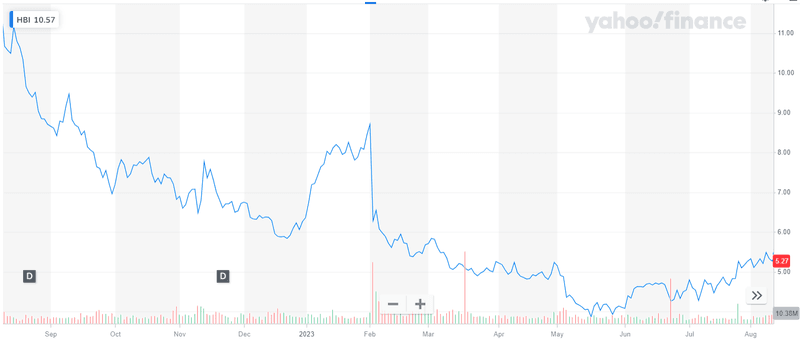Hanesbrands Inc: Does The Activist Investor Shakeup Indicate The Possibility Of A Turnaround?

Hanesbrands Inc. (NYSE:HBI), renowned for its Hanes underwear and Champion sportswear, is currently under the scrutiny of Barington Capital Group LP, a New York-based hedge fund. Barington, which has acquired a stake in Hanesbrands amounting to less than 1%, is engaged in active discussions with the management and board of Hanesbrands. The hedge fund's primary contention is the underwhelming performance of Hanesbrands in comparison to its industry peers and the broader market, attributing this lag to a perceived stagnation in innovation and focus. Now, we are aware that Hanesbrands stock price has been on the downslide and its current market capitalization is $1.86 billion making it fall within our definition of small-caps. Let us have a closer look at the company and see if there is any potential for a turnaround given the current situation.
Company Overview
The company's expansive operations are strategically divided into three primary segments: Innerwear, Activewear, and International. Its diverse product portfolio encompasses men's underwear, women's panties, children’s undergarments, socks, and activewear. Beyond these basics, Hanesbrands offers a broad spectrum of intimate apparel, which includes bras, shapewear, and home goods. Additionally, their product range is further amplified with offerings like T-shirts, fleece, sport shirts, performance apparel, and thermals. Notably, the company has secured licensing rights for its renowned Champion brand, extending its reach into footwear and sports accessories. A distinguishing feature of Hanesbrands lies in its powerful array of brand names, with notable mentions like Hanes, Champion, Maidenform, Bali, Polo Ralph Lauren, Playtex, and many more. Its marketing approach is multifaceted, reaching consumers through retailers, wholesalers, and third-party embellishers, both locally and on an international scale, encompassing regions such as the Americas, Europe, and Asia Pacific.
Business Model & Challenging Market Dynamics
Hanesbrands, with its established emphasis on branded innerwear and activewear, is enriched by its time-honored brands like Hanes and Champion. These brands, deeply embedded within the US fashion landscape, serve distinctive consumer needs: Hanes with its array of essential wear and Champion, presenting athletic apparel. However, in the rapidly evolving fashion ecosystem, where consumer preferences change and competition thrives due to e-commerce proliferation, both brands face their own challenges. Hanes seems to grapple with an increasing competition, rendering its value proposition less distinctive, while Champion, despite its commendable comeback between 2015-2020, is waning post its high-profile collaborations with Supreme. The collaborative venture with Supreme, then a fashion juggernaut, made Champion a nostalgic icon for streetwear enthusiasts. Yet, Champion's subsequent endeavors seem lackluster; with questionable pricing strategies and a plethora of products persistently on sale, its revived popularity appears to be short-lived.
Hanesbrands, in its effort to connect with consumers, leverages a diverse channel strategy, encompassing retail, wholesale, and e-commerce. This diversified presence positions them against purely e-commerce retailers, while their partnership with giants like Walmart, accounting for 16% of their sales, strengthens their market foothold. However, amidst observed commercial challenges, the company introduced its ambitious "Full Potential Plan" comprising four strategic pillars, including globally amplifying Champion's presence, rejuvenating Innerwear by targeting younger demographics, enhancing e-commerce competence, and refining their global portfolio. The objectives sound promising, but the lingering skepticism stems from the management's past performance. If Champion couldn't retain its rekindled appeal, even after teaming up with a global sensation like Supreme, there's a genuine concern if the management's current strategies can truly reshape Hanesbrands' future trajectory.
A Complex Competitive Landscape
Hanesbrands, in the apparel domain, contends with formidable competitors such as Fruit of the Loom, PVH Corp, Ralph Lauren, Gildan, Tapestry, adidas, Nike, and V.F. Corporation. Over time, this illustrious lineup has overshadowed Hanesbrands, indicated by its tepid growth trajectory. Addressing this demands a strategic shift, particularly in how Hanesbrands interacts with its clientele. Embracing the digital age means ramping up its social media footprint and aligning product innovation with consumer inclinations. The rise of e-commerce presents both a challenge and an opportunity. Hanesbrands can enhance its direct-to-consumer model, minimizing wholesale dependency. This not only optimizes sales economics by bypassing intermediaries but is also contingent on building a personal brand-customer bond, necessitating astute marketing. An international foray could be the silver lining, especially in burgeoning markets. Despite the recent hiccups Champion faced domestically in 2022, its international reception was commendable. As global economies burgeon, the allure for Western brands, like Hanesbrands, is likely to surge. The onus is now on the brand to chart a path that capitalizes on these opportunities while warding off challenges.
Shakeup By Activist Investor
The activist investor, Barington's recommendations for the apparel giant include amplifying its profitability, meticulously recalibrating its portfolio, rejuvenating the board, and considering the divestiture of some non-central brands, notably Playtex and Wonderbra. Their contention stems from the belief that profitability can see a boost through strategic cost reductions, augmented investments in product development and marketing, and possible asset sales. An additional concern raised by Barington revolves around the composition of Hanesbrands' board, emphasizing the integration of more independent directors equipped with relevant sector-specific expertise. They argue that prolonged tenures of some board members might be hindering effective oversight.
Over the years, Hanesbrands has broadened its horizon through strategic acquisitions like Maidenform, Gear for Sports, and Alternative Apparel. However, some argue that such moves have not only impacted the company's profitability and debt metrics but have also overshadowed its core brands. In our view, Barington's concerns and suggestions appear to be valid. In this case, it is essential to note Barington's track record. The hedge fund is known for its proactive stance with consumer-centric companies, including Darden Restaurants Inc., Avon Products Inc., and Children's Place Inc. Barington's modus operandi predominantly revolves around collaborative engagements with boards and management teams, as opposed to aggressive public campaigns or proxy battles. However, the effectiveness of these collaborations is yet to be seen in the case of Hanesbrands.
Final thoughts

Source: Yahoo Finance
We can see there has been a palpable decline in consumer interest, leading to diminishing growth and deteriorating profit margins which is why Barington's recommendations do make sense. Present market dynamics and foreseeable headwinds cast a shadow over its short-term prospects, and we have little optimism for a significant turnaround in the upcoming quarters, especially given the fluctuating nature of wholesale demand. The management's past execution strategies haven't yielded the desired results, further clouding its path to resurgence. Overall, we believe that Hanesbrands is best avoided despite the shake up by Barington and we believe it will continue to underperform when benchmarked against its industry counterparts.



